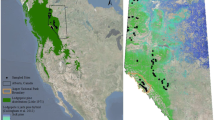Abstract
In populations of dioecious plants, the differences in the cost of reproduction between male and female plants can promote a male-biased sex ratio. In this study, we examine the macronutrient levels in tissues of the dioecious wetland shrub Myrica gale to identify the cost of reproduction for male and female plants and to examine the effect of nutrients on the apparent sex ratio at the ramet level. We examined plants across 12 populations of M. gale inhabiting bogs and fens in Japan. For each population, we used line transects to estimate the apparent sex ratio and measured the concentrations of nitrogen (N), phosphorus (P), and potassium (K) in the leaves sampled from male and female plants and in the fruits from female plants. For five of the populations, we calculated the flowering frequency, mortality, and the recruitment rate (as the rate of clonal propagation). We found that the proportion of females was positively affected, and the male bias of sex ratios reduced, by increases in P concentration in leaves sampled from female plants. Neither mortality nor recruitment was affected by sex or by the nutrient concentration (P, K). The flowering frequency was not affected by sex or by K concentration, but decreased with decreases in the P concentration measured in leaves. This study confirmed that reproduction in M. gale is P-limited. We found no distinct differences in the flowering frequency, mortality, or recruitment rate between the male and female plants.






Similar content being viewed by others
References
Allen GA, Antos JA (1993) Sex-ratio variation in the dioecious shrub Oemleria cerasiformis. Am Nat 141:537–553
Bierzychudek P, Eckhart V (1988) Spatial segregation of the sexes of dioecious plants. Am Nat 132:34–43
Bobbink R, Hicks K, Galloway J, Spranger T, Alkemade R, Ashmore M, Bustamante M, Cinderby S, Davidson E, Dentener F et al (2010) Global assessment of nitrogen deposition effects on terrestrial plant diversity: a synthesis. Ecol Appl 20:30–59
Chapin IFSPAM, Vitousek PM (2012) Principles of terrestrial ecosystem ecology, Second edition. Springer, New York
Cipollini ML, Whigham DF (1994) Sexual dimorphism and cost of reproduction in the dioecious shrub Lindera benzoin (Lauraceae). Amer J Bot 81:65–75
Cox PA (1981) Niche partitioning between the sexes of dioecious plants. Am Nat 117:295–307
Darwin C (1877) The differnt forms of flowers on plants of the same species. Murray, London (reprinted 1896. D Appleton, NewYork)
Davey A, Gibson C (1917) Notes on the distribution of sexes in Myrica gale. New Phytol 16:147–151
Delph LF (1999) Sexual dimorphism in life history. In: Geber MA, Dawson TE, Delph LF (eds) Gender and sexual dimorphism in flowering plants. Springer, Berlin, pp 149–174
Field DL, Pickup M, Barrett SCH (2013) Comparative analyses of sex-ratio variation in dioecious flowering plants. Evolution 67:661–672
Garcia MB, Antor RJ (1995) Sex-ratio and sexual dimorphism in the dioecious Borderea pyrenaica (Dioscoreaceae). Oecologia 101:59–67
Gehring JL, Monson RK (1994) Sexual differences in gas-exchange and response to environmental-stress in dioecious Silene latifolia (Careyophyllaceae). Amer J Bot 81:166–174
Güsewell S (2004) N:P ratios in terrestrial plants: variation and functional significance. New Phytol 164:243–266
Hoosbeek MR, Van Breemen N, Vasander H, Buttler A, Berendse F (2002) Potassium limits potential growth of bog vegetation under elevated atmospheric CO2 and N deposition. Glob Change Biol 8:1130–1138
Huguet V, Mergeay M, Cervantes E, Fernandez MP (2004) Diversity of Frankia strains associated to Myrica gale in Western Europe: impact of host plant (Myrica vs. Alnus) and of edaphic factors. Environ Microbiol 6:1032–1041
Koerselman W, Meuleman AFM (1996) The vegetation N:P ratio: a new tool to detect the nature of nutrient limitation. J Appl Ecol 33:1441–1450
Lloyd DG (1981) The distribution of sex in Myrica gale. Plant Syst Evol 138:29–45
Lloyd DG, Webb CJ (1977) Secondary sex characteristics in plants. Bot Rev 43:177–216
Mizuki I, Kume A, Chiwa M, Uehara Y, Ishida K (2012) Impact of soil water chemistry on the apparent sex ratio of the flowering ramets of the dioecious plant Myrica gale var. tomentosa. J Plant Res 125:631–641
Obeso JR (2002) The costs of reproduction in plants. New Phytol 155:321–348
Olde Venterink H, Pieterse NM, Belgers JDM, Wassen MJ, De Ruiter PC (2002) N, P, and K budgets along nutrient availability and productivity gradients in wetlands. Ecol Appl 12:1010–1026
Petry WK, Soule JD, Iler AM, Chicas-Mosier A, Inouye DW, Miller TEX, Mooney KA (2016) Sex-specific responses to climate change in plants alter population sex ratio and performance. Science 353:69–71
Renner SS, Ricklefs RE (1995) Dioecy and its correlates in the flowering plants. Amer J Bot 82:596–606
Shaver GR, Melillo JM (1984) Nutrient budgets of marsh plants—efficiency concepts and relation to availability. Ecology 65:1491–1510
Skene KR, Sprent JI, Raven JA, Herdman L (2000) Myrica gale L.. J Ecol 88:1079–1094
Uehara Y, Kume A, Chiwa M, Honoki H, Zhang J, Watanabe K (2015) Atmospheric deposition and interactions with Pinus pumila regal canopy on Mount Tateyama in the Northern Japanese Alps. Arct Antarctic Alp Res 47:389–399
Wright VL, Dorken ME (2014) Sexual dimorphism in leaf nitrogen content but not photosynthetic rates in Sagittaria latifolia (Alismataceae). Botany 92:109–112
Zuur AF, Ieno EN, Walker NJ, Saveliev AA, Smith GM (2009) Mixed effects models and extentions in ecology with R. Springer, New York
Acknowledgements
We thank Ph.D., Yoichi Watanabe, Tomoka Sato, and Keiko Hashimoto for help with the field work. The research was supported by JSPS KAKENHI (Grant numbers 18380099, 19780119, and 21380087). We would like to thank Enago (http://www.eneago.jp) for the English language review.
Author information
Authors and Affiliations
Corresponding author
Electronic supplementary material
Below is the link to the electronic supplementary material.
Rights and permissions
About this article
Cite this article
Mizuki, I., Ishida, K., Chiwa, M. et al. Nutrient deficiency promotes male-biased apparent sex ratios at the ramet level in the dioecious plant Myrica gale var. tomentosa in oligotrophic environments in bogs. J Plant Res 131, 973–985 (2018). https://doi.org/10.1007/s10265-018-1056-3
Received:
Accepted:
Published:
Issue Date:
DOI: https://doi.org/10.1007/s10265-018-1056-3




